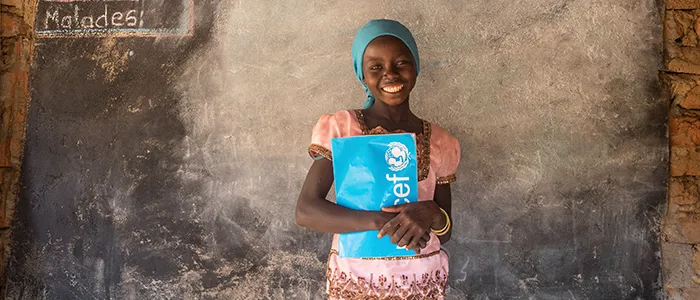
Girls’ education through UNICEF

For more than 70 years, UNICEF has been committed to ensuring that all children – including girls – can access a quality education. Across all education programs, UNICEF addresses the financial, social and gender barriers that impact girls’ access to school. All of this is possible thanks to the generosity of UNICEF supporters.
Examples of UNICEF education projects
Every child has the right to an education regardless of who they are, where they live or how much money their family has. In 155 countries around the world, UNICEF works to provide learning opportunities that begin in early childhood and that prepare every child with the knowledge and skills they need to thrive.
UNICEF is a global leader in supporting girls’ education. UNICEF:
- Advocates for a girl’s right to education:
Niger – Fewer than 10% of the poorest girls of lower secondary-school age are in school (2017 data). Advocacy by UNICEF contributed to raising the compulsory age of schooling for girls to 16.
- Removes financial barriers:
Madagascar – In 2017, cash transfers helped over 21,000 out-of-school girls re-enter school, including almost 5,000 girls at the lower secondary-education level. Cash transfers help girls who face financial challenges to overcome indirect costs of schooling, such as purchasing school uniforms, reference books, or transport to school.
Nigeria – A UNICEF-supported cash transfer scheme in the states of Niger and Sokoto increased girls’ enrolment by 30%.
- Tackles socio-cultural barriers to adolescent girls’ education:
UNICEF works with governments and partners to develop menstrual hygiene management (MHM) guidelines, and packages of interventions aimed at keeping girls in schools. This includes improving sanitation services and gender-segregated bathroom facilities to allow girls to manage their menstruation in a dignified way without discomfort or embarrassment. Between 2014 – 2017 UNICEF supported more than 50,000 schools with integrating MHM guidelines into school curricula.
- Supports girls to learn and to transition from education to decent work:
Lebanon – Information technology-related projects promoted STEM (Science, Technology, Engineering, Math) subjects as career pathways for girls, reaching 19,000 girls throughout the country in 2017.
Snapshots of UNICEF’s Commitment to Quality Education
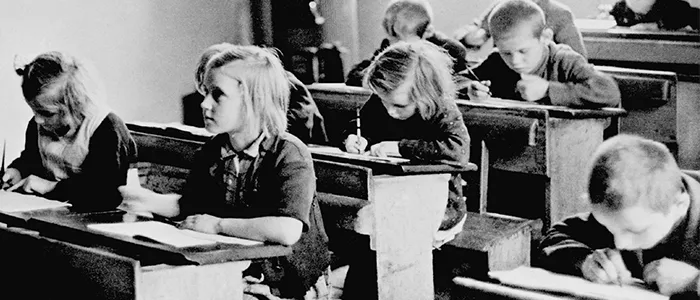
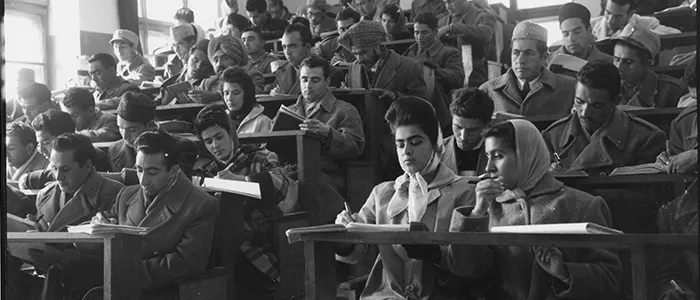
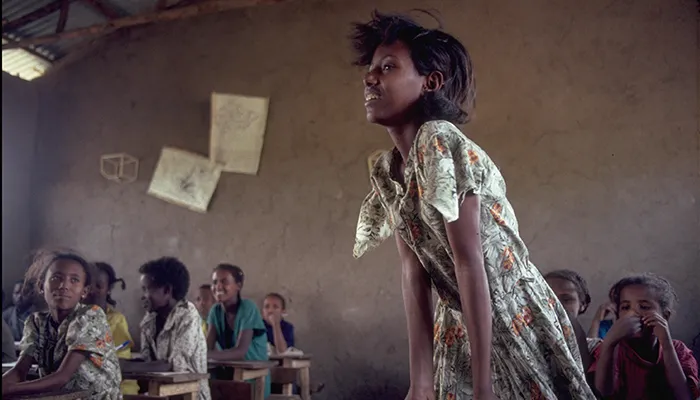
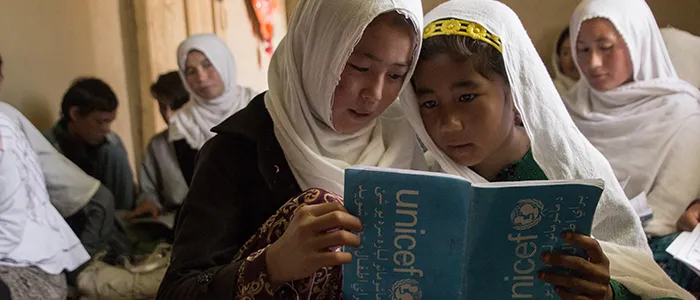
The power of education
Education offers children a ladder out of poverty and a path to a promising future. However, about 263 million boys and girls around the world do not have the opportunity to start or complete school.
The many problems girls (and children) are facing
A child’s access to education is often determined by circumstances such as:
- Gender
- Location
- Armed conflict
- Disability and poverty
Worse, exclusion from school fuels intergenerational cycles of poverty and disadvantage. It robs societies of a source of dynamic growth and development, and a chance to build social cohesion and reduce tensions that can spark violence.
Why are girls out of school?
Girls face enormous gender and socio-economic barriers to achieving quality education:
- Traditional attitudes and practices, including child marriage and early pregnancy, often force girls to drop out of school;
- Poverty and gender inequality mean families favour boys when investing in education and drive girls to engage in domestic work, including caring for siblings or fetching water instead of going to school;
- Instability due to civil unrest, war and famine may limit girls’ access to education;
- Many schools do not meet the needs of adolescent girls with inadequate sanitation services and access to bathroom facilities, keeping girls out of class;
- Poor-quality learning materials, facilities and poorly trained teachers also affect girls’ learning; and
- Dangerously long commutes to schools and violence in schools will stop girls from attending.
The power of educating girls
There are more than 1.1 billion girls in the world today. They are part of a vibrant generation poised to take on the future. Investing in their education allows them to build better lives for themselves and contribute to the health, safety and prosperity of their families, communities and the world. We know that the advantages of investing in girls’ secondary education, and not just primary education, can change families, communities and economies. But in low-income countries, less than two thirds of girls complete their primary education, and only 1 in 3 girls completes lower secondary school.
5 facts on how girls’ education can change the world
In low-income countries, universal secondary education for young women can mean:
- Girls earning double the income of out-of-school children by adulthood, and reporting higher standards of living, including having enough money to buy food for their families;
- Virtually eliminating child marriage and starkly reducing early childbearing – which also helps put a stop to social isolation, interrupted schooling and limited opportunities for career and vocation advancement;
- Reducing child deaths by one fifth and reducing the risk of malnutrition among their children.
- Combating cholera, HIV-AIDS, malaria and other life-threatening diseases by incorporating prevention measures into life-skills curricula, and school-run knowledge and awareness-raising campaigns; and
- Improving a woman’s sense of psychological well-being and reducing the risk of intimate-partner violence.
Girls from rural Zambia attended an internship called ‘Zambia Girls 2030’ that changed their lives. Most had never used a computer, but during the internship they got the chance to develop some of the skills they need to chase their dreams and secure a job. With the right support — from family, friends or mentors — girls like Salia are ready for the future.
What UNICEF is doing to help girls and boys access quality education
From 2014 to 2017, UNICEF:
- Provided over 59 million children with learning materials, like reading and textbooks, tablets, computers, education games and school kits. Learning materials have the power to transmit knowledge, build skills and shape the way children interact with the world.
- Supplied education materials to more than 1 million classrooms. And this support went beyond procuring supplies – UNICEF was involved in developing, updating, analyzing and reviewing teacher learning materials in over 50 countries.
- Trained nearly 183,000 school communities and parent-teacher associations on topics such as school management, planning, health and hygiene, inclusive education and financial management.
EDUCATION FOR CHILDREN IN EMERGENCIES
The world has seen a rising number of crises stemming from conflict, natural disasters and epidemics. Worse, many crises are prolonged, spanning entire childhoods and persisting for generations. When they disrupt schooling, it not only undermines children’s present well-being, but also puts their futures – and those of their societies – in jeopardy.
Only 50% of refugee children are enrolled in primary school. Children uprooted by crises lose more than a roof over their heads. Without education, they risk losing their futures.
For children in emergencies, education is life-saving. Schools:
- Give children stability and structure to help cope with the trauma they have experienced.
- Can protect children from the physical dangers around them, including abuse, exploitation and recruitment into armed groups.
- Can provide children with other life-saving interventions, such as food, water, sanitation and health.
When children get an education, despite adverse circumstances, whole societies benefit: education can boost economic growth, reduce poverty and inequality. Education also contributes to restoring peace and stability. Yet, despite the enormous benefits to children, education is often the first service suspended and the last restored in crisis-affected communities.
UNICEF is continually advancing efforts to reach out-of-school children who live in conflict-affected areas. In 2017 alone, UNICEF reached 8.8 million children in emergencies with access to education.
4 things you can do to help support girls’ and boys’ access to education
- Donate
A monthly or a one-time donation to UNICEF Canada goes a long way to helping children around the world. Your gift enables the protection, care, support and services all children need to survive and thrive.
- Shop for a better world for children
Give the gift of education for one or more girls. Change their lives by sending them to school and providing essential learning supplies. UNICEF Canada’s Survival Gifts® are real gifts with real impact that are guaranteed to reach children in the world’s toughest places, when they need them most. Whether you buy on behalf of yourself or as a gift for a loved one, you will make a real difference to children who need help.
- Learn more about the importance of education
Read more about UNICEF’s research and reports grounded in empirical data, rigorous research and thoughtful analysis, bringing results for children.
- Discover UNICEF’s work in education, thanks to donor support
Read more about the amazing results for children that UNICEF has achieved, made possible through support from our donors.
Page last updated October 2018.
